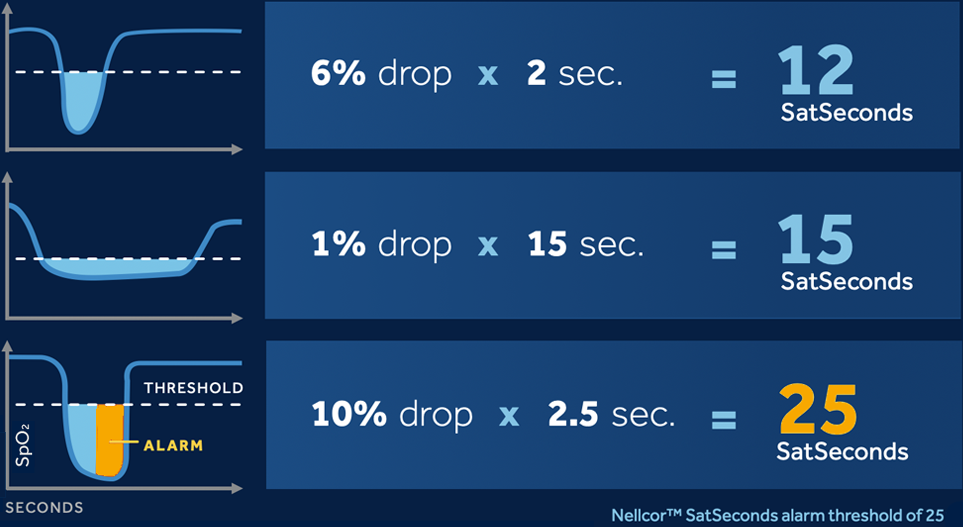It’s frustrating to respond to alarms that don’t need clinical intervention. We know alarm fatigue is real. And it can negatively impact your workflow, your patient’s experience, and your ability to provide the best possible care. That’s why when you hear an alarm, it’s vital to be able to trust it.
![]()
SpO2 is the most common alarm in the hospital1
85–99% of alarms don’t require clinical intervention2
SatSeconds alarm management may reduce nuisance alarms in neonates by 40%, enhancing your ability to focus3
Movement can set off alarms—even when there is no desaturation event. The SatSeconds alarm management feature has been tested under motion conditions to ensure you can trust the alarm.
Nellcor™ SatSeconds alarm management
![]()
Tested under real clinical motion conditions4
The proprietary Nellcor™ SatSeconds algorithm works on a basic formula — generating alarms based on the severity of a drop in SpO2 and the length of the drop. SatSeconds filters out a very short dip in SpO2 which may help reduce nuisance alarms by 40% in neonates and minimize alarm fatigue. If SpO2 drops below the alarm threshold for a longer period, the alarm will sound. So, you know the alarm is significant.

 The Vital Sync™ solution gives you nearly real-time, actionable information
The Vital Sync™ solution gives you nearly real-time, actionable information
that your clinical teams can access anytime, anywhere. Vital Sync™ solution allows
remote monitoring including alarm management, reporting, and EMR
connectivity on almost any device.
![]() ▪ Remote access
▪ Remote access
▪ Alarm forwarding
▪ Central monitoring
Be virtually with your patients anytime, wherever you are and prioritize care.
Medtronic is a proud sponsor of the AAMI Foundation’s National Coalition for Alarm Management and Safety.The AAMI offers an
SpO2 alarm management toolkit that provides resources, strategies, and approaches mitigating clinically insignificant alarms.
LEARN MORE >
Is alarm fatigue a real thing in your unit? We innovate with you and your patients in mind. Let us hear about your challenges.
1. Nellcor™ Oxygen Saturation Accuracy Specification Grid. Medtronic. http://www.medtronic.com/content/dam/covidien/Websites/mitg/com/sustainability/uniform-sensor-accuracy-guide.pdf. Accessed September 2, 2016.
2. FDA 510(k): Masimo™* K101896 – Masimo™* Sensor Accuracy.
3. Bebout DE, Mannheimer PD, Wun C-C. Site-dependent differences in the time to detect changes in saturation during low perfusion. Crit Care Med. 2001;29(12)A115.
4. Medtronic Reports: BRPMS Essential Requirements Matrix (Doc no. 10099165); Clinical, Motion, Connery OEM Module (Doc no. 10096395); and Clinical Report-COVMOPR0384, Motion, LAMP‑C (internal Doc no. 10099560).
5. Addison PS, Mannheimer PD, Ochs J. Pulse rate performance of two pulse oximeters during challenging monitoring conditions. 2013 [White Paper].
6. Batchelder K, Sethi R, Eng B, Pinto YJ. Pulse rate performance of two pulse oximeters in the NICU. 2015 [White Paper].
7. Louie A, Feiner JR, et al. Four types of pulse oximeters accurately detect hypoxia during low perfusion and motion. Anesthesiology. 2018;128:520-30.
† Comparison between the published FDA cleared labeling for Nellcor™ MAXA, MAXAL, MAXN, MAXP, MAXI and MAXFAST sensors and Masimo™* LNCS sensors.
© 2020 Medtronic. All rights reserved. Medtronic, Medtronic logo and Further, Together are trademarks of Medtronic. ™* Third party brands are trademarks of their respective owners. All other brands are trademarks of a Medtronic company.